Critical Evaluation of Research Articles on Early Childhood Ed
VerifiedAdded on 2023/04/23
|10
|2802
|355
Report
AI Summary
This report provides a critical analysis of two research articles focusing on early childhood education, specifically pre-school readiness and dual language settings. It compares the appropriateness of data collection methods, ethical considerations, and research validity in each study. Article 1 employs a quantitative approach using electrical surveys, while Article 2 uses qualitative semi-structured interviews. The analysis highlights the ethical considerations addressed in both studies, including respectful behavior, participant consent, and confidentiality. The report also evaluates the internal and external validity of each research approach, concluding that Article 2 demonstrates greater validity due to its more comprehensive data collection and unbiased population sample. The application of research findings discusses the importance of pre-schooling and dual language settings in early childhood development, emphasizing the role of educators and parents in fostering emotional, social, and communication skills. Ultimately, the report concludes that Article 2's qualitative research method provides a more effective and valid approach to understanding early childhood education.
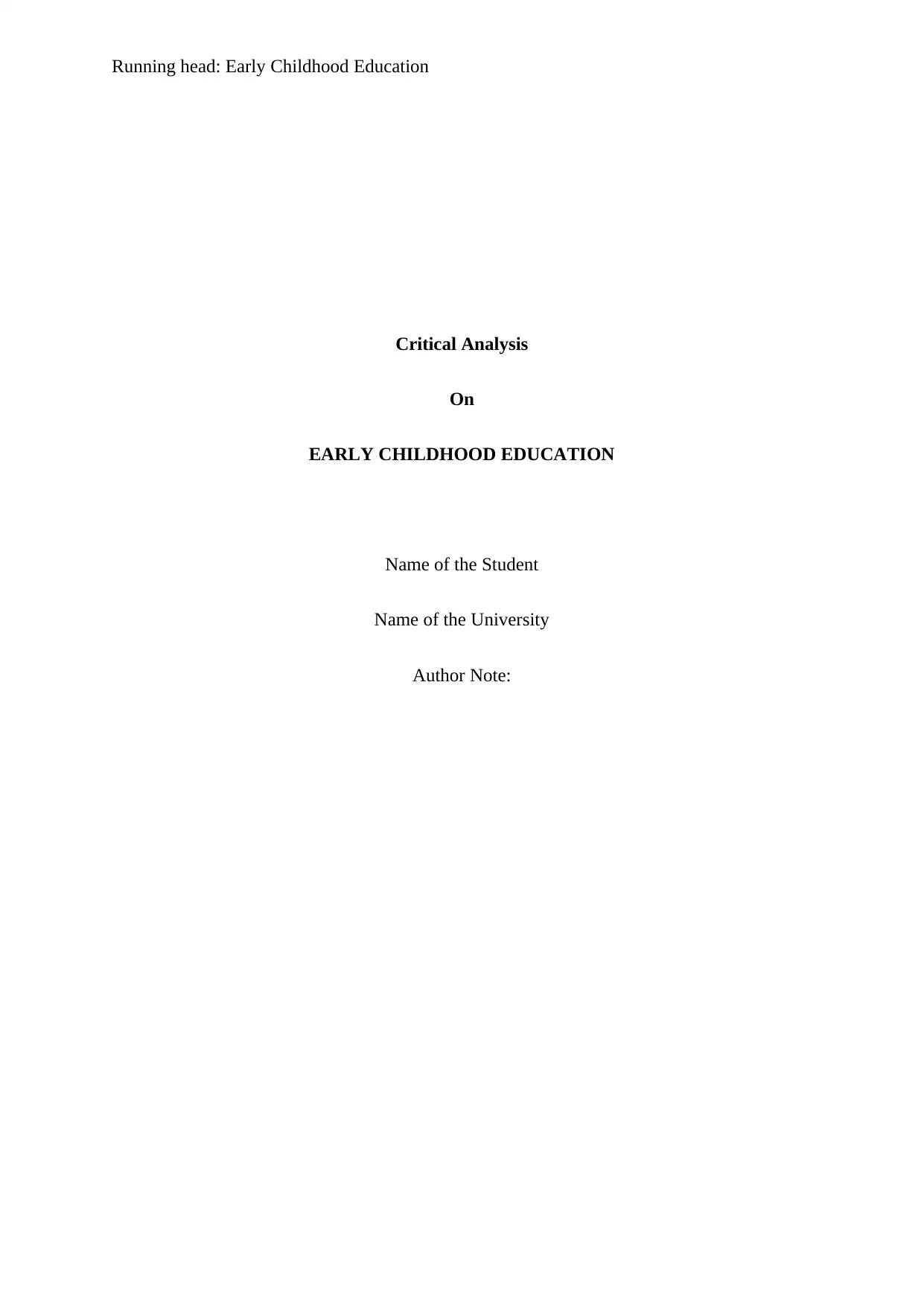
Running head: Early Childhood Education
Critical Analysis
On
EARLY CHILDHOOD EDUCATION
Name of the Student
Name of the University
Author Note:
Critical Analysis
On
EARLY CHILDHOOD EDUCATION
Name of the Student
Name of the University
Author Note:
Paraphrase This Document
Need a fresh take? Get an instant paraphrase of this document with our AI Paraphraser
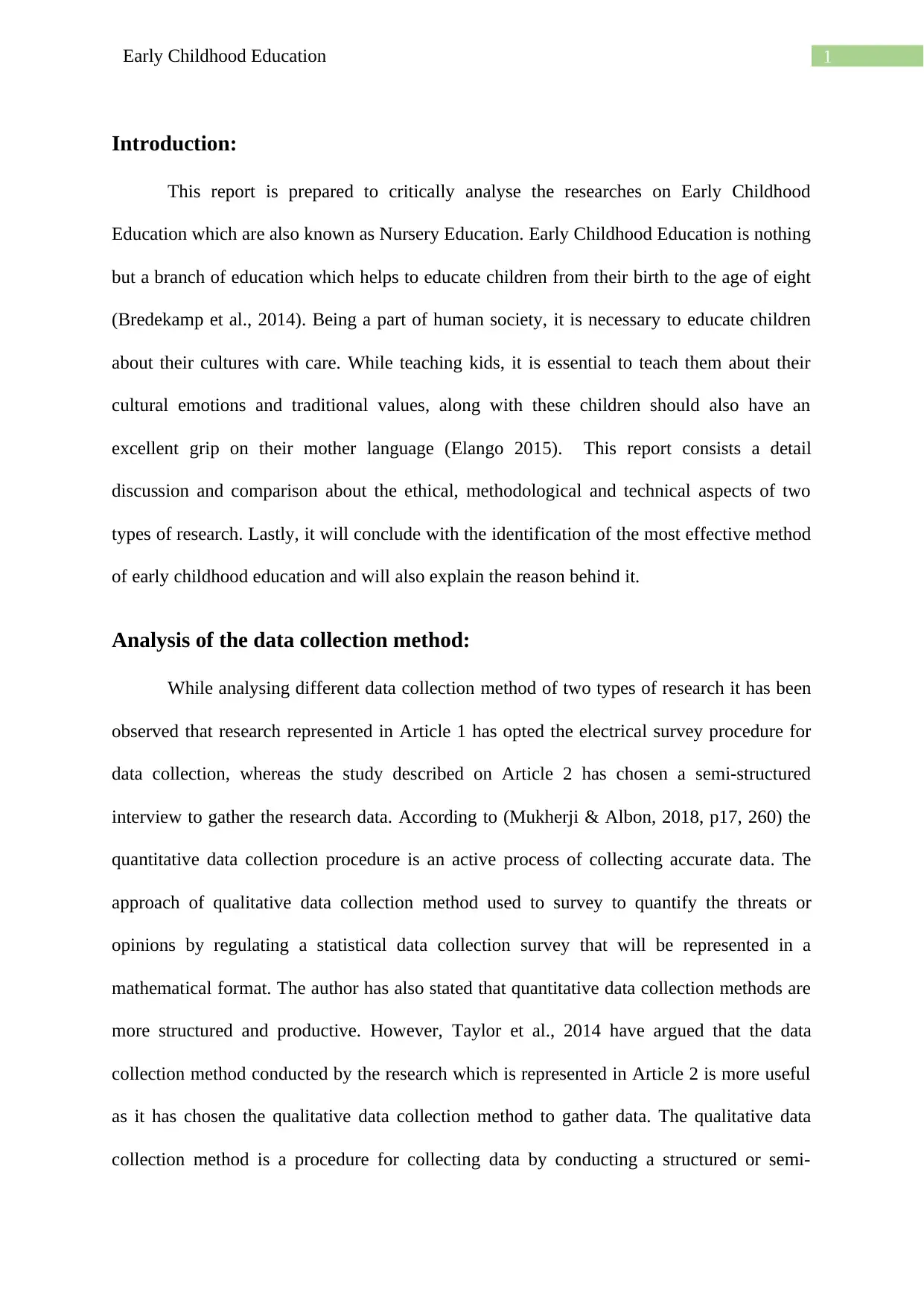
1Early Childhood Education
Introduction:
This report is prepared to critically analyse the researches on Early Childhood
Education which are also known as Nursery Education. Early Childhood Education is nothing
but a branch of education which helps to educate children from their birth to the age of eight
(Bredekamp et al., 2014). Being a part of human society, it is necessary to educate children
about their cultures with care. While teaching kids, it is essential to teach them about their
cultural emotions and traditional values, along with these children should also have an
excellent grip on their mother language (Elango 2015). This report consists a detail
discussion and comparison about the ethical, methodological and technical aspects of two
types of research. Lastly, it will conclude with the identification of the most effective method
of early childhood education and will also explain the reason behind it.
Analysis of the data collection method:
While analysing different data collection method of two types of research it has been
observed that research represented in Article 1 has opted the electrical survey procedure for
data collection, whereas the study described on Article 2 has chosen a semi-structured
interview to gather the research data. According to (Mukherji & Albon, 2018, p17, 260) the
quantitative data collection procedure is an active process of collecting accurate data. The
approach of qualitative data collection method used to survey to quantify the threats or
opinions by regulating a statistical data collection survey that will be represented in a
mathematical format. The author has also stated that quantitative data collection methods are
more structured and productive. However, Taylor et al., 2014 have argued that the data
collection method conducted by the research which is represented in Article 2 is more useful
as it has chosen the qualitative data collection method to gather data. The qualitative data
collection method is a procedure for collecting data by conducting a structured or semi-
Introduction:
This report is prepared to critically analyse the researches on Early Childhood
Education which are also known as Nursery Education. Early Childhood Education is nothing
but a branch of education which helps to educate children from their birth to the age of eight
(Bredekamp et al., 2014). Being a part of human society, it is necessary to educate children
about their cultures with care. While teaching kids, it is essential to teach them about their
cultural emotions and traditional values, along with these children should also have an
excellent grip on their mother language (Elango 2015). This report consists a detail
discussion and comparison about the ethical, methodological and technical aspects of two
types of research. Lastly, it will conclude with the identification of the most effective method
of early childhood education and will also explain the reason behind it.
Analysis of the data collection method:
While analysing different data collection method of two types of research it has been
observed that research represented in Article 1 has opted the electrical survey procedure for
data collection, whereas the study described on Article 2 has chosen a semi-structured
interview to gather the research data. According to (Mukherji & Albon, 2018, p17, 260) the
quantitative data collection procedure is an active process of collecting accurate data. The
approach of qualitative data collection method used to survey to quantify the threats or
opinions by regulating a statistical data collection survey that will be represented in a
mathematical format. The author has also stated that quantitative data collection methods are
more structured and productive. However, Taylor et al., 2014 have argued that the data
collection method conducted by the research which is represented in Article 2 is more useful
as it has chosen the qualitative data collection method to gather data. The qualitative data
collection method is a procedure for collecting data by conducting a structured or semi-
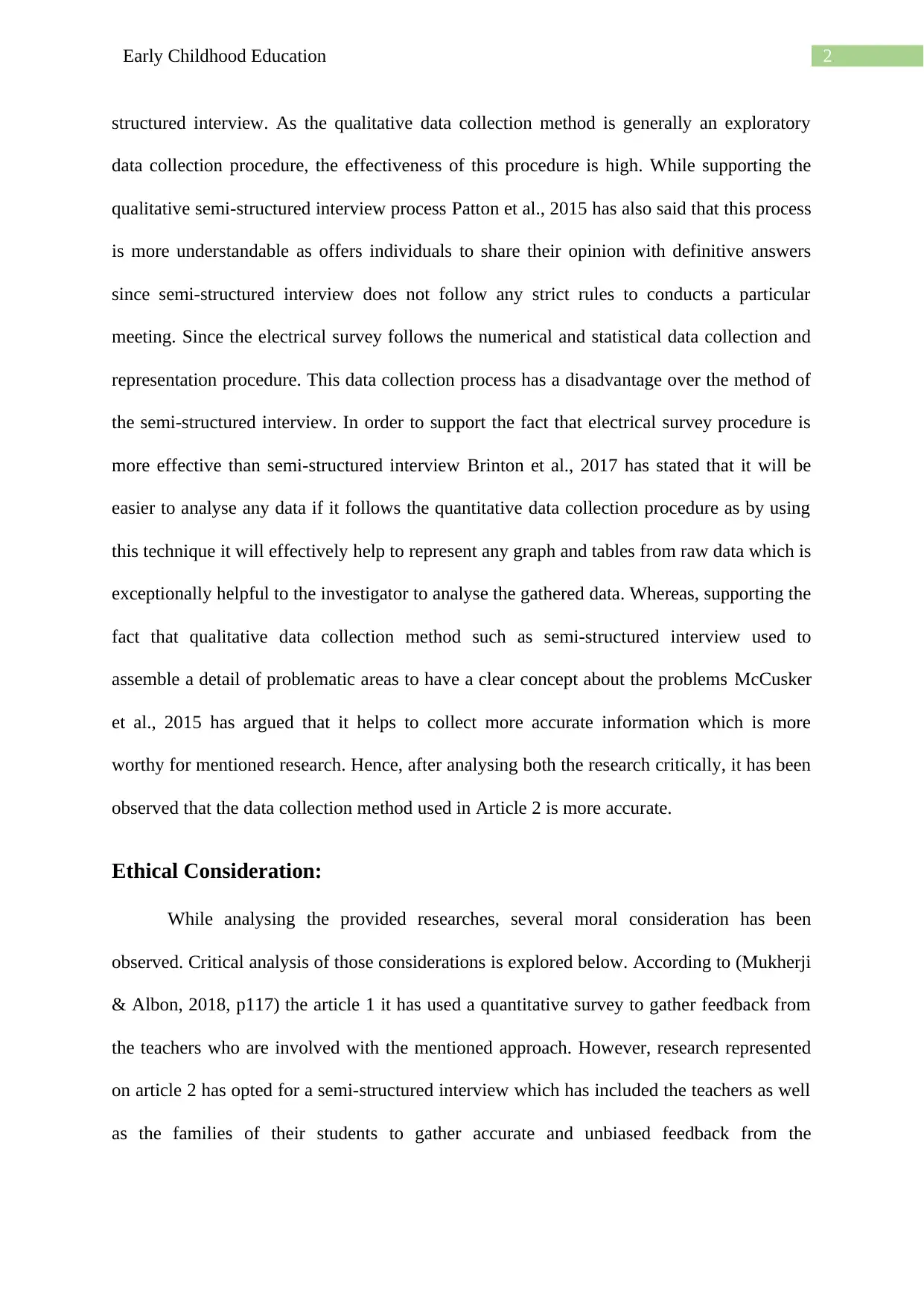
2Early Childhood Education
structured interview. As the qualitative data collection method is generally an exploratory
data collection procedure, the effectiveness of this procedure is high. While supporting the
qualitative semi-structured interview process Patton et al., 2015 has also said that this process
is more understandable as offers individuals to share their opinion with definitive answers
since semi-structured interview does not follow any strict rules to conducts a particular
meeting. Since the electrical survey follows the numerical and statistical data collection and
representation procedure. This data collection process has a disadvantage over the method of
the semi-structured interview. In order to support the fact that electrical survey procedure is
more effective than semi-structured interview Brinton et al., 2017 has stated that it will be
easier to analyse any data if it follows the quantitative data collection procedure as by using
this technique it will effectively help to represent any graph and tables from raw data which is
exceptionally helpful to the investigator to analyse the gathered data. Whereas, supporting the
fact that qualitative data collection method such as semi-structured interview used to
assemble a detail of problematic areas to have a clear concept about the problems McCusker
et al., 2015 has argued that it helps to collect more accurate information which is more
worthy for mentioned research. Hence, after analysing both the research critically, it has been
observed that the data collection method used in Article 2 is more accurate.
Ethical Consideration:
While analysing the provided researches, several moral consideration has been
observed. Critical analysis of those considerations is explored below. According to (Mukherji
& Albon, 2018, p117) the article 1 it has used a quantitative survey to gather feedback from
the teachers who are involved with the mentioned approach. However, research represented
on article 2 has opted for a semi-structured interview which has included the teachers as well
as the families of their students to gather accurate and unbiased feedback from the
structured interview. As the qualitative data collection method is generally an exploratory
data collection procedure, the effectiveness of this procedure is high. While supporting the
qualitative semi-structured interview process Patton et al., 2015 has also said that this process
is more understandable as offers individuals to share their opinion with definitive answers
since semi-structured interview does not follow any strict rules to conducts a particular
meeting. Since the electrical survey follows the numerical and statistical data collection and
representation procedure. This data collection process has a disadvantage over the method of
the semi-structured interview. In order to support the fact that electrical survey procedure is
more effective than semi-structured interview Brinton et al., 2017 has stated that it will be
easier to analyse any data if it follows the quantitative data collection procedure as by using
this technique it will effectively help to represent any graph and tables from raw data which is
exceptionally helpful to the investigator to analyse the gathered data. Whereas, supporting the
fact that qualitative data collection method such as semi-structured interview used to
assemble a detail of problematic areas to have a clear concept about the problems McCusker
et al., 2015 has argued that it helps to collect more accurate information which is more
worthy for mentioned research. Hence, after analysing both the research critically, it has been
observed that the data collection method used in Article 2 is more accurate.
Ethical Consideration:
While analysing the provided researches, several moral consideration has been
observed. Critical analysis of those considerations is explored below. According to (Mukherji
& Albon, 2018, p117) the article 1 it has used a quantitative survey to gather feedback from
the teachers who are involved with the mentioned approach. However, research represented
on article 2 has opted for a semi-structured interview which has included the teachers as well
as the families of their students to gather accurate and unbiased feedback from the
⊘ This is a preview!⊘
Do you want full access?
Subscribe today to unlock all pages.

Trusted by 1+ million students worldwide
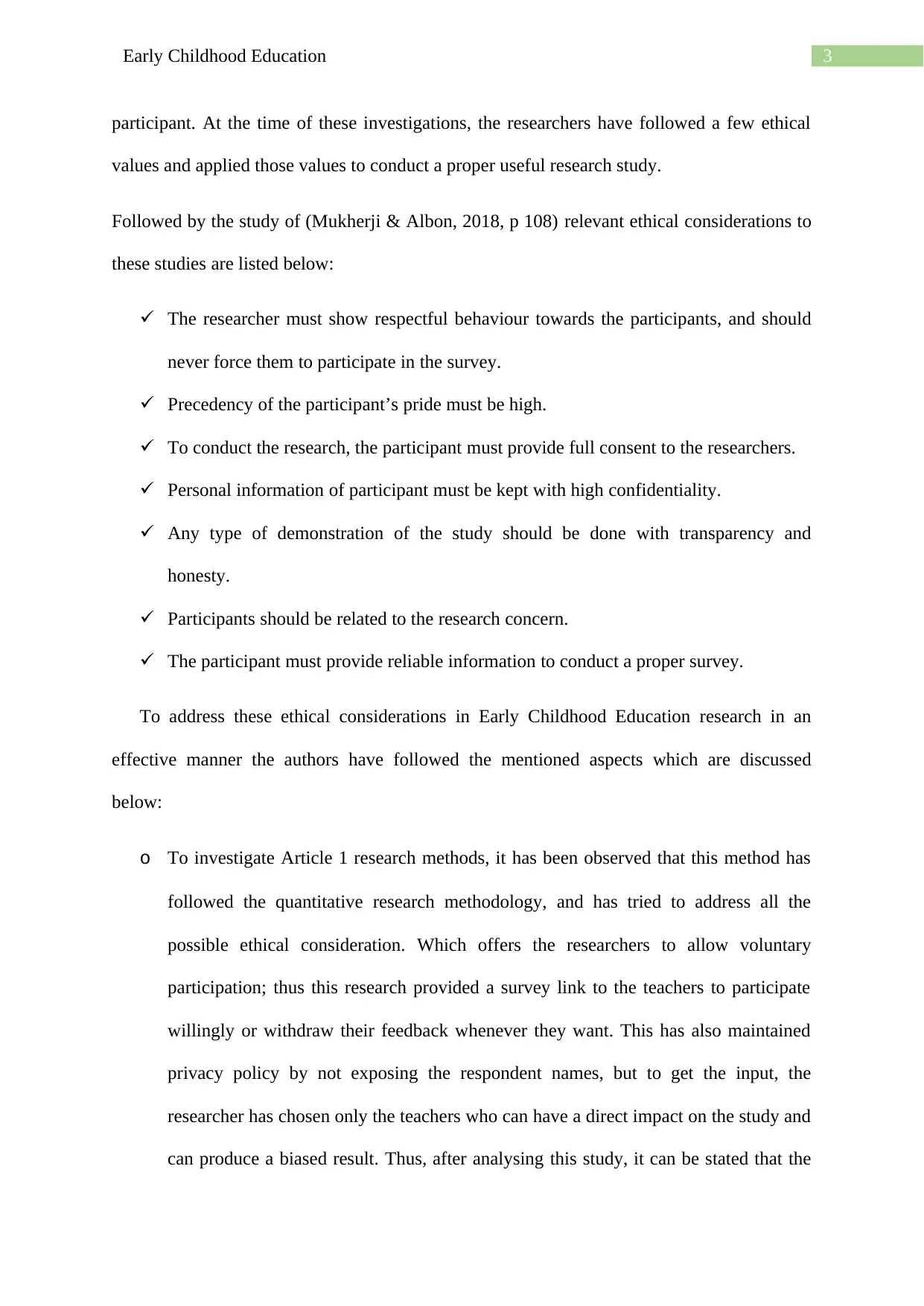
3Early Childhood Education
participant. At the time of these investigations, the researchers have followed a few ethical
values and applied those values to conduct a proper useful research study.
Followed by the study of (Mukherji & Albon, 2018, p 108) relevant ethical considerations to
these studies are listed below:
The researcher must show respectful behaviour towards the participants, and should
never force them to participate in the survey.
Precedency of the participant’s pride must be high.
To conduct the research, the participant must provide full consent to the researchers.
Personal information of participant must be kept with high confidentiality.
Any type of demonstration of the study should be done with transparency and
honesty.
Participants should be related to the research concern.
The participant must provide reliable information to conduct a proper survey.
To address these ethical considerations in Early Childhood Education research in an
effective manner the authors have followed the mentioned aspects which are discussed
below:
o To investigate Article 1 research methods, it has been observed that this method has
followed the quantitative research methodology, and has tried to address all the
possible ethical consideration. Which offers the researchers to allow voluntary
participation; thus this research provided a survey link to the teachers to participate
willingly or withdraw their feedback whenever they want. This has also maintained
privacy policy by not exposing the respondent names, but to get the input, the
researcher has chosen only the teachers who can have a direct impact on the study and
can produce a biased result. Thus, after analysing this study, it can be stated that the
participant. At the time of these investigations, the researchers have followed a few ethical
values and applied those values to conduct a proper useful research study.
Followed by the study of (Mukherji & Albon, 2018, p 108) relevant ethical considerations to
these studies are listed below:
The researcher must show respectful behaviour towards the participants, and should
never force them to participate in the survey.
Precedency of the participant’s pride must be high.
To conduct the research, the participant must provide full consent to the researchers.
Personal information of participant must be kept with high confidentiality.
Any type of demonstration of the study should be done with transparency and
honesty.
Participants should be related to the research concern.
The participant must provide reliable information to conduct a proper survey.
To address these ethical considerations in Early Childhood Education research in an
effective manner the authors have followed the mentioned aspects which are discussed
below:
o To investigate Article 1 research methods, it has been observed that this method has
followed the quantitative research methodology, and has tried to address all the
possible ethical consideration. Which offers the researchers to allow voluntary
participation; thus this research provided a survey link to the teachers to participate
willingly or withdraw their feedback whenever they want. This has also maintained
privacy policy by not exposing the respondent names, but to get the input, the
researcher has chosen only the teachers who can have a direct impact on the study and
can produce a biased result. Thus, after analysing this study, it can be stated that the
Paraphrase This Document
Need a fresh take? Get an instant paraphrase of this document with our AI Paraphraser
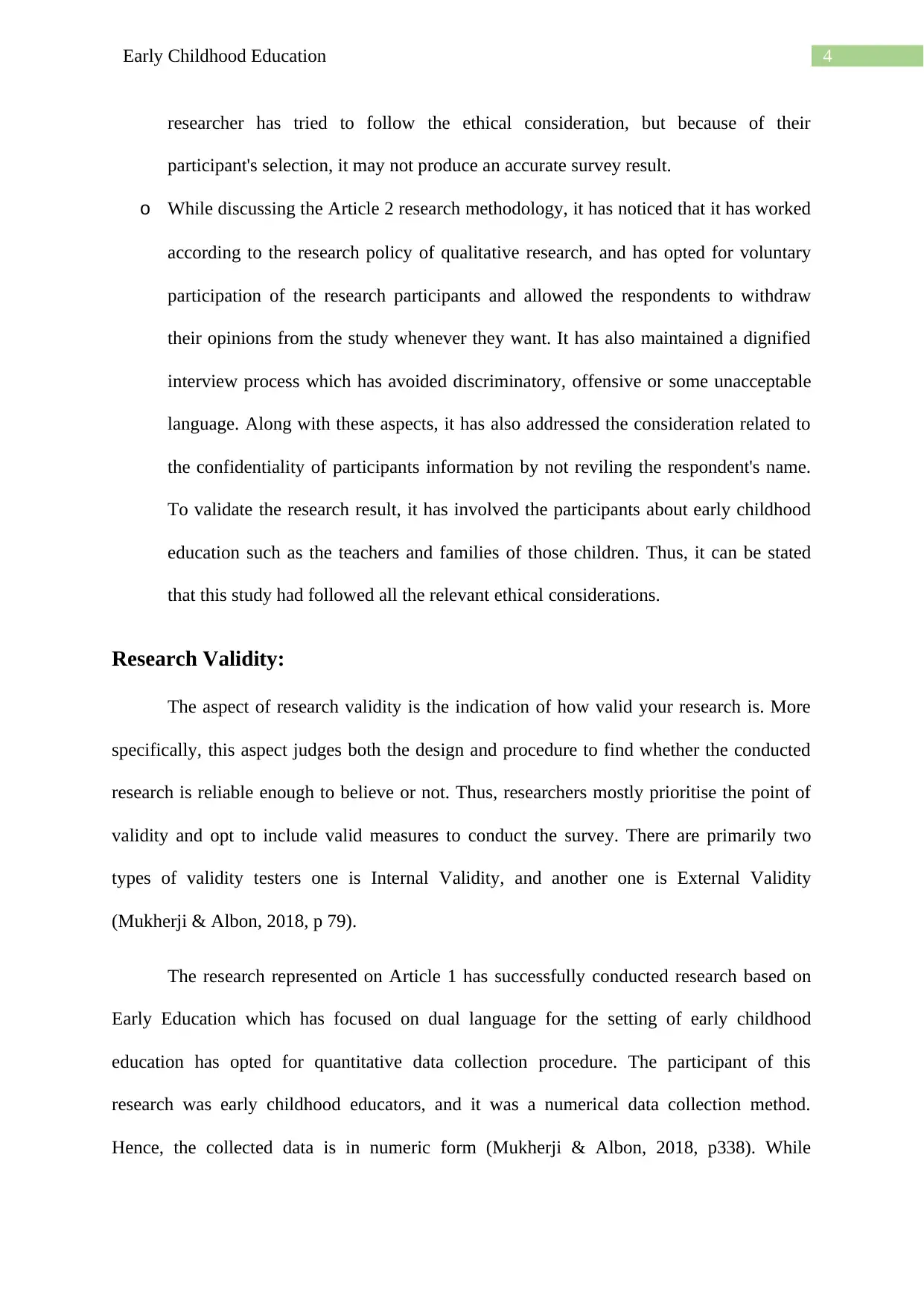
4Early Childhood Education
researcher has tried to follow the ethical consideration, but because of their
participant's selection, it may not produce an accurate survey result.
o While discussing the Article 2 research methodology, it has noticed that it has worked
according to the research policy of qualitative research, and has opted for voluntary
participation of the research participants and allowed the respondents to withdraw
their opinions from the study whenever they want. It has also maintained a dignified
interview process which has avoided discriminatory, offensive or some unacceptable
language. Along with these aspects, it has also addressed the consideration related to
the confidentiality of participants information by not reviling the respondent's name.
To validate the research result, it has involved the participants about early childhood
education such as the teachers and families of those children. Thus, it can be stated
that this study had followed all the relevant ethical considerations.
Research Validity:
The aspect of research validity is the indication of how valid your research is. More
specifically, this aspect judges both the design and procedure to find whether the conducted
research is reliable enough to believe or not. Thus, researchers mostly prioritise the point of
validity and opt to include valid measures to conduct the survey. There are primarily two
types of validity testers one is Internal Validity, and another one is External Validity
(Mukherji & Albon, 2018, p 79).
The research represented on Article 1 has successfully conducted research based on
Early Education which has focused on dual language for the setting of early childhood
education has opted for quantitative data collection procedure. The participant of this
research was early childhood educators, and it was a numerical data collection method.
Hence, the collected data is in numeric form (Mukherji & Albon, 2018, p338). While
researcher has tried to follow the ethical consideration, but because of their
participant's selection, it may not produce an accurate survey result.
o While discussing the Article 2 research methodology, it has noticed that it has worked
according to the research policy of qualitative research, and has opted for voluntary
participation of the research participants and allowed the respondents to withdraw
their opinions from the study whenever they want. It has also maintained a dignified
interview process which has avoided discriminatory, offensive or some unacceptable
language. Along with these aspects, it has also addressed the consideration related to
the confidentiality of participants information by not reviling the respondent's name.
To validate the research result, it has involved the participants about early childhood
education such as the teachers and families of those children. Thus, it can be stated
that this study had followed all the relevant ethical considerations.
Research Validity:
The aspect of research validity is the indication of how valid your research is. More
specifically, this aspect judges both the design and procedure to find whether the conducted
research is reliable enough to believe or not. Thus, researchers mostly prioritise the point of
validity and opt to include valid measures to conduct the survey. There are primarily two
types of validity testers one is Internal Validity, and another one is External Validity
(Mukherji & Albon, 2018, p 79).
The research represented on Article 1 has successfully conducted research based on
Early Education which has focused on dual language for the setting of early childhood
education has opted for quantitative data collection procedure. The participant of this
research was early childhood educators, and it was a numerical data collection method.
Hence, the collected data is in numeric form (Mukherji & Albon, 2018, p338). While
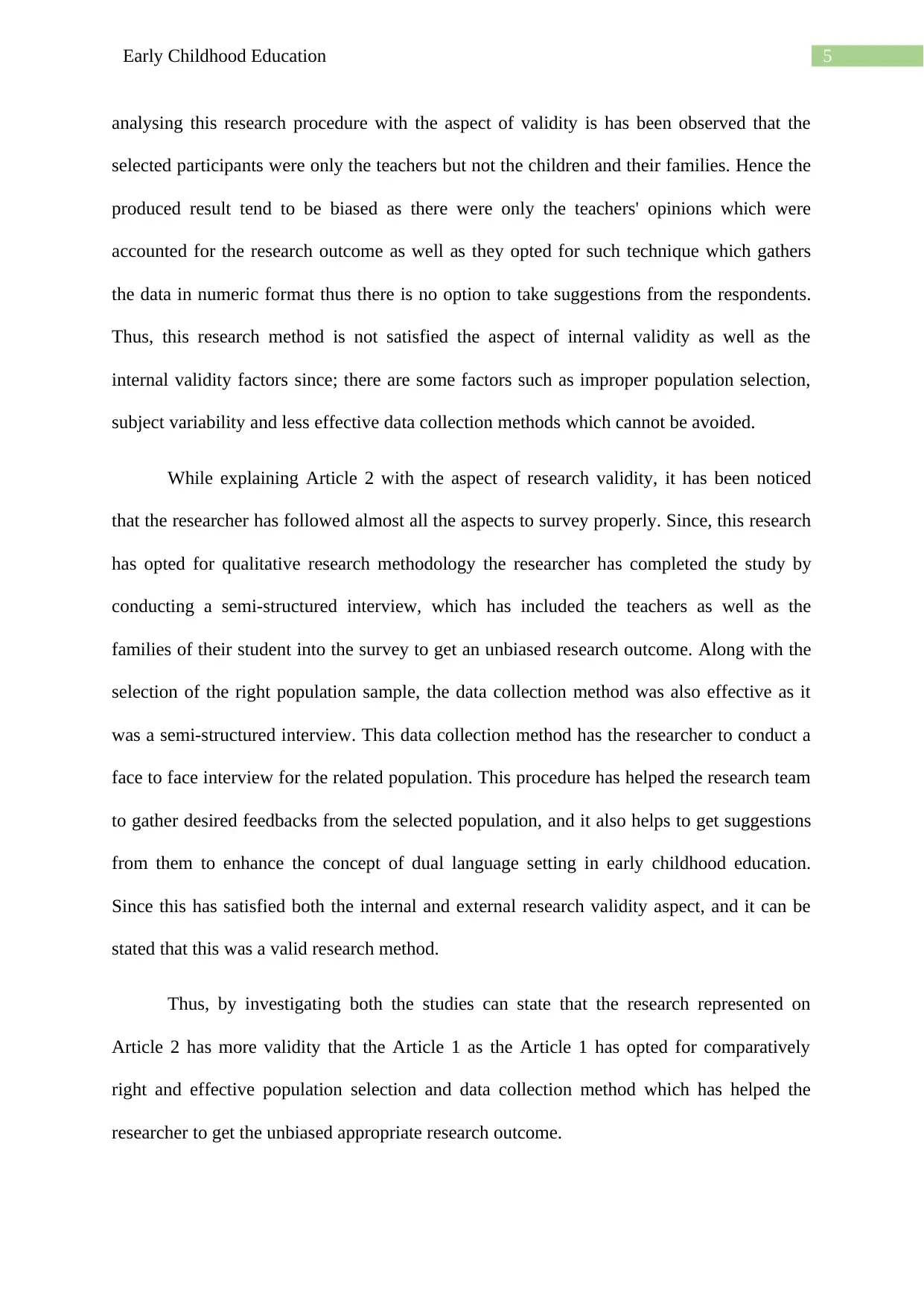
5Early Childhood Education
analysing this research procedure with the aspect of validity is has been observed that the
selected participants were only the teachers but not the children and their families. Hence the
produced result tend to be biased as there were only the teachers' opinions which were
accounted for the research outcome as well as they opted for such technique which gathers
the data in numeric format thus there is no option to take suggestions from the respondents.
Thus, this research method is not satisfied the aspect of internal validity as well as the
internal validity factors since; there are some factors such as improper population selection,
subject variability and less effective data collection methods which cannot be avoided.
While explaining Article 2 with the aspect of research validity, it has been noticed
that the researcher has followed almost all the aspects to survey properly. Since, this research
has opted for qualitative research methodology the researcher has completed the study by
conducting a semi-structured interview, which has included the teachers as well as the
families of their student into the survey to get an unbiased research outcome. Along with the
selection of the right population sample, the data collection method was also effective as it
was a semi-structured interview. This data collection method has the researcher to conduct a
face to face interview for the related population. This procedure has helped the research team
to gather desired feedbacks from the selected population, and it also helps to get suggestions
from them to enhance the concept of dual language setting in early childhood education.
Since this has satisfied both the internal and external research validity aspect, and it can be
stated that this was a valid research method.
Thus, by investigating both the studies can state that the research represented on
Article 2 has more validity that the Article 1 as the Article 1 has opted for comparatively
right and effective population selection and data collection method which has helped the
researcher to get the unbiased appropriate research outcome.
analysing this research procedure with the aspect of validity is has been observed that the
selected participants were only the teachers but not the children and their families. Hence the
produced result tend to be biased as there were only the teachers' opinions which were
accounted for the research outcome as well as they opted for such technique which gathers
the data in numeric format thus there is no option to take suggestions from the respondents.
Thus, this research method is not satisfied the aspect of internal validity as well as the
internal validity factors since; there are some factors such as improper population selection,
subject variability and less effective data collection methods which cannot be avoided.
While explaining Article 2 with the aspect of research validity, it has been noticed
that the researcher has followed almost all the aspects to survey properly. Since, this research
has opted for qualitative research methodology the researcher has completed the study by
conducting a semi-structured interview, which has included the teachers as well as the
families of their student into the survey to get an unbiased research outcome. Along with the
selection of the right population sample, the data collection method was also effective as it
was a semi-structured interview. This data collection method has the researcher to conduct a
face to face interview for the related population. This procedure has helped the research team
to gather desired feedbacks from the selected population, and it also helps to get suggestions
from them to enhance the concept of dual language setting in early childhood education.
Since this has satisfied both the internal and external research validity aspect, and it can be
stated that this was a valid research method.
Thus, by investigating both the studies can state that the research represented on
Article 2 has more validity that the Article 1 as the Article 1 has opted for comparatively
right and effective population selection and data collection method which has helped the
researcher to get the unbiased appropriate research outcome.
⊘ This is a preview!⊘
Do you want full access?
Subscribe today to unlock all pages.

Trusted by 1+ million students worldwide
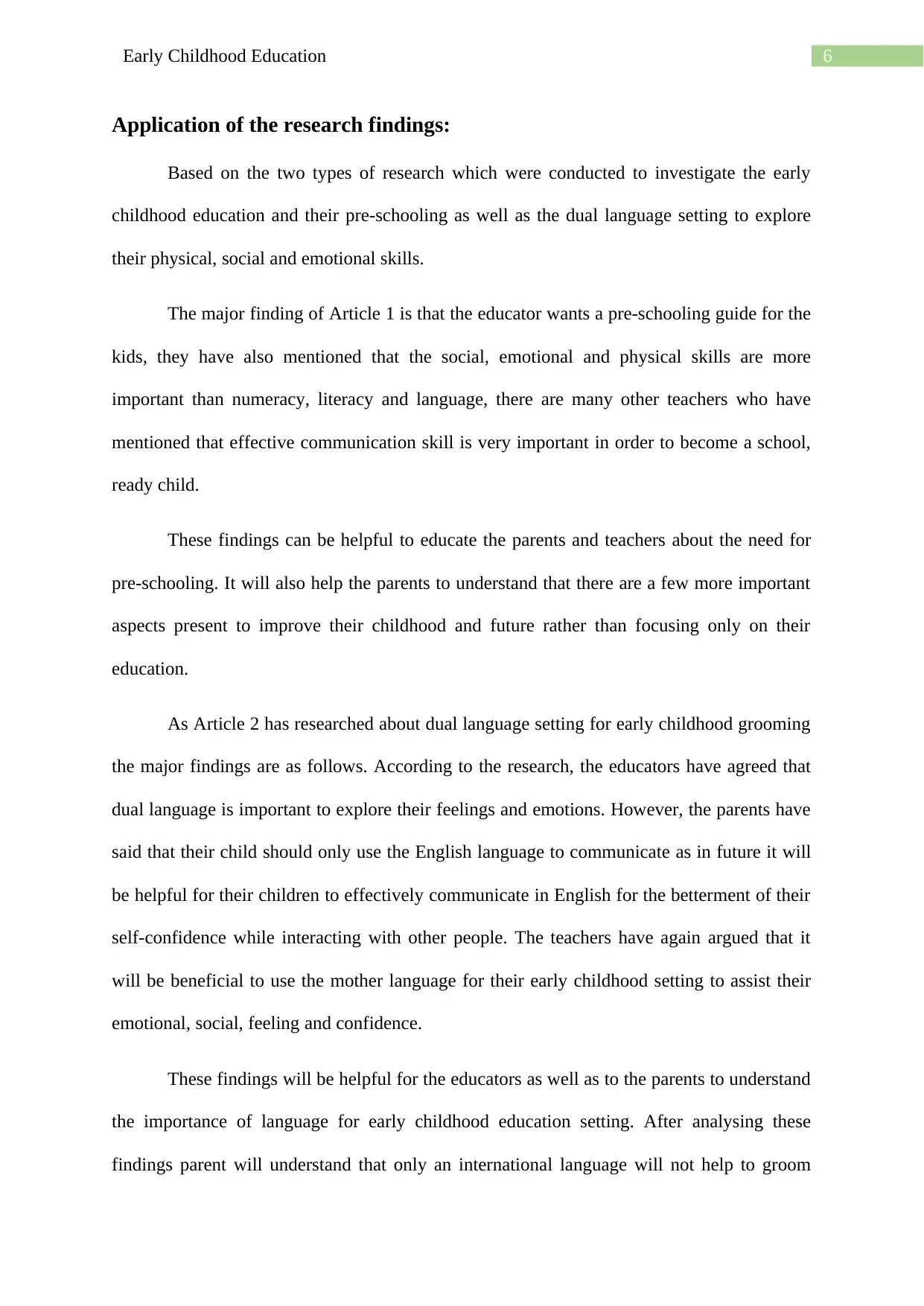
6Early Childhood Education
Application of the research findings:
Based on the two types of research which were conducted to investigate the early
childhood education and their pre-schooling as well as the dual language setting to explore
their physical, social and emotional skills.
The major finding of Article 1 is that the educator wants a pre-schooling guide for the
kids, they have also mentioned that the social, emotional and physical skills are more
important than numeracy, literacy and language, there are many other teachers who have
mentioned that effective communication skill is very important in order to become a school,
ready child.
These findings can be helpful to educate the parents and teachers about the need for
pre-schooling. It will also help the parents to understand that there are a few more important
aspects present to improve their childhood and future rather than focusing only on their
education.
As Article 2 has researched about dual language setting for early childhood grooming
the major findings are as follows. According to the research, the educators have agreed that
dual language is important to explore their feelings and emotions. However, the parents have
said that their child should only use the English language to communicate as in future it will
be helpful for their children to effectively communicate in English for the betterment of their
self-confidence while interacting with other people. The teachers have again argued that it
will be beneficial to use the mother language for their early childhood setting to assist their
emotional, social, feeling and confidence.
These findings will be helpful for the educators as well as to the parents to understand
the importance of language for early childhood education setting. After analysing these
findings parent will understand that only an international language will not help to groom
Application of the research findings:
Based on the two types of research which were conducted to investigate the early
childhood education and their pre-schooling as well as the dual language setting to explore
their physical, social and emotional skills.
The major finding of Article 1 is that the educator wants a pre-schooling guide for the
kids, they have also mentioned that the social, emotional and physical skills are more
important than numeracy, literacy and language, there are many other teachers who have
mentioned that effective communication skill is very important in order to become a school,
ready child.
These findings can be helpful to educate the parents and teachers about the need for
pre-schooling. It will also help the parents to understand that there are a few more important
aspects present to improve their childhood and future rather than focusing only on their
education.
As Article 2 has researched about dual language setting for early childhood grooming
the major findings are as follows. According to the research, the educators have agreed that
dual language is important to explore their feelings and emotions. However, the parents have
said that their child should only use the English language to communicate as in future it will
be helpful for their children to effectively communicate in English for the betterment of their
self-confidence while interacting with other people. The teachers have again argued that it
will be beneficial to use the mother language for their early childhood setting to assist their
emotional, social, feeling and confidence.
These findings will be helpful for the educators as well as to the parents to understand
the importance of language for early childhood education setting. After analysing these
findings parent will understand that only an international language will not help to groom
Paraphrase This Document
Need a fresh take? Get an instant paraphrase of this document with our AI Paraphraser
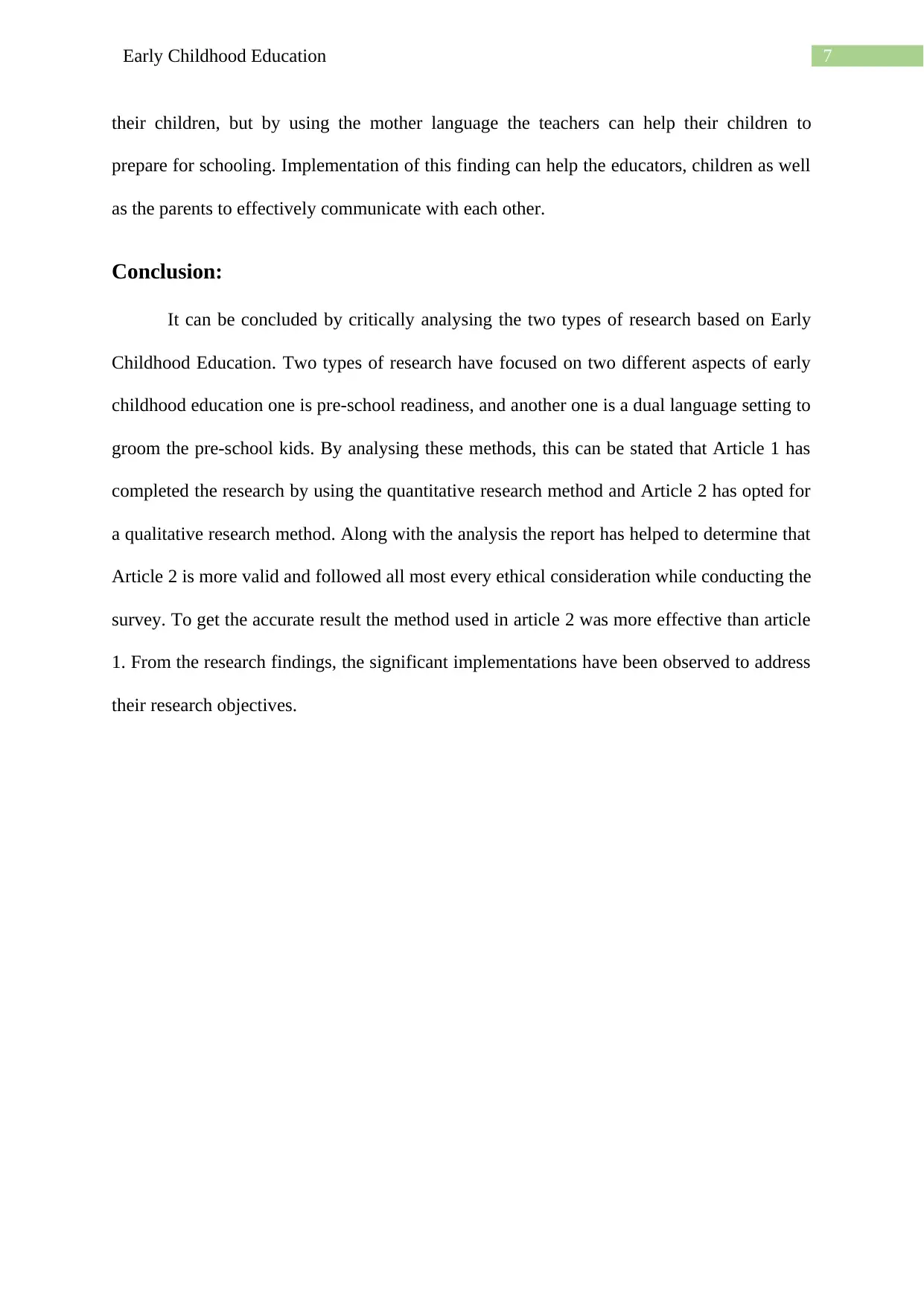
7Early Childhood Education
their children, but by using the mother language the teachers can help their children to
prepare for schooling. Implementation of this finding can help the educators, children as well
as the parents to effectively communicate with each other.
Conclusion:
It can be concluded by critically analysing the two types of research based on Early
Childhood Education. Two types of research have focused on two different aspects of early
childhood education one is pre-school readiness, and another one is a dual language setting to
groom the pre-school kids. By analysing these methods, this can be stated that Article 1 has
completed the research by using the quantitative research method and Article 2 has opted for
a qualitative research method. Along with the analysis the report has helped to determine that
Article 2 is more valid and followed all most every ethical consideration while conducting the
survey. To get the accurate result the method used in article 2 was more effective than article
1. From the research findings, the significant implementations have been observed to address
their research objectives.
their children, but by using the mother language the teachers can help their children to
prepare for schooling. Implementation of this finding can help the educators, children as well
as the parents to effectively communicate with each other.
Conclusion:
It can be concluded by critically analysing the two types of research based on Early
Childhood Education. Two types of research have focused on two different aspects of early
childhood education one is pre-school readiness, and another one is a dual language setting to
groom the pre-school kids. By analysing these methods, this can be stated that Article 1 has
completed the research by using the quantitative research method and Article 2 has opted for
a qualitative research method. Along with the analysis the report has helped to determine that
Article 2 is more valid and followed all most every ethical consideration while conducting the
survey. To get the accurate result the method used in article 2 was more effective than article
1. From the research findings, the significant implementations have been observed to address
their research objectives.
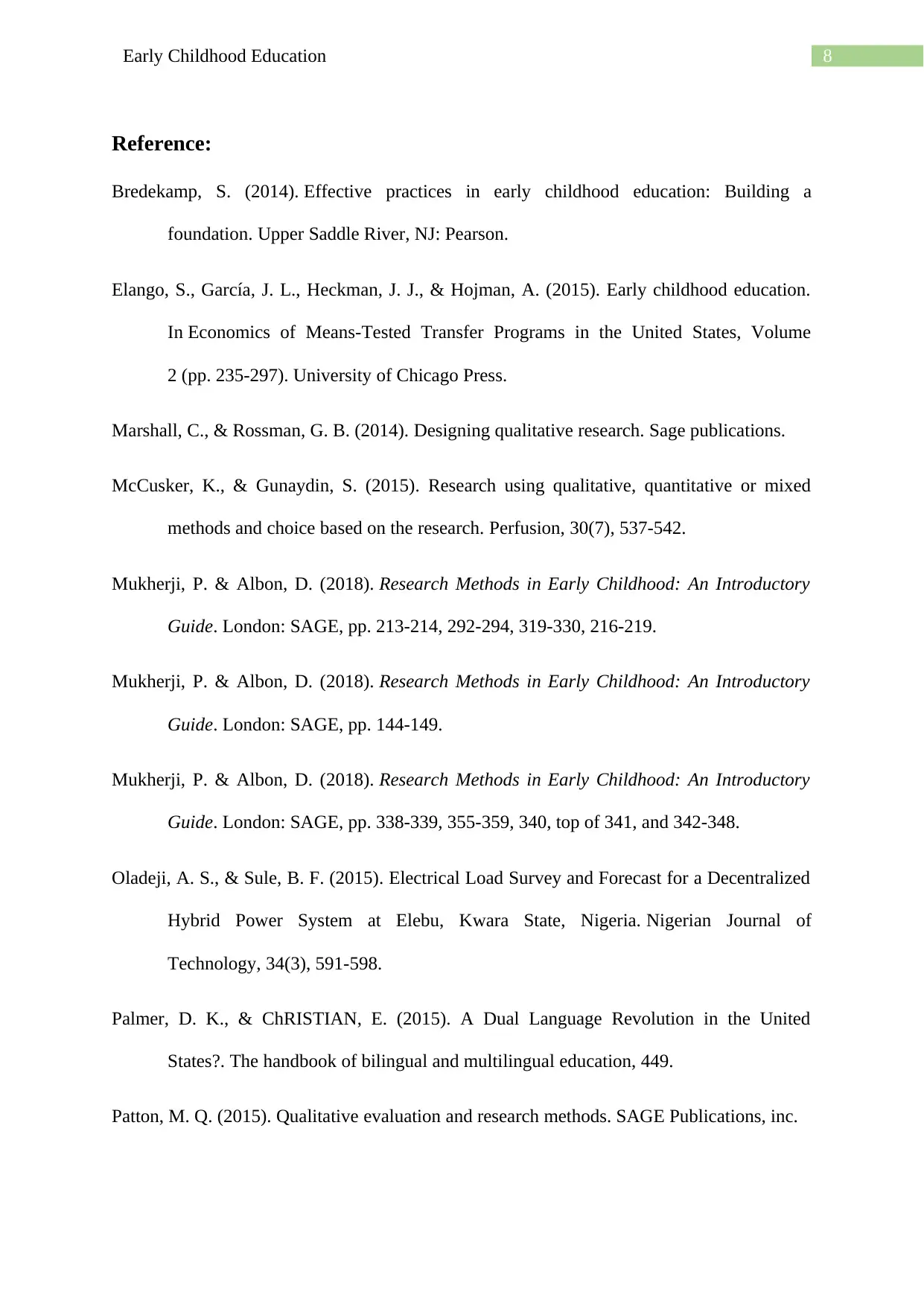
8Early Childhood Education
Reference:
Bredekamp, S. (2014). Effective practices in early childhood education: Building a
foundation. Upper Saddle River, NJ: Pearson.
Elango, S., García, J. L., Heckman, J. J., & Hojman, A. (2015). Early childhood education.
In Economics of Means-Tested Transfer Programs in the United States, Volume
2 (pp. 235-297). University of Chicago Press.
Marshall, C., & Rossman, G. B. (2014). Designing qualitative research. Sage publications.
McCusker, K., & Gunaydin, S. (2015). Research using qualitative, quantitative or mixed
methods and choice based on the research. Perfusion, 30(7), 537-542.
Mukherji, P. & Albon, D. (2018). Research Methods in Early Childhood: An Introductory
Guide. London: SAGE, pp. 213-214, 292-294, 319-330, 216-219.
Mukherji, P. & Albon, D. (2018). Research Methods in Early Childhood: An Introductory
Guide. London: SAGE, pp. 144-149.
Mukherji, P. & Albon, D. (2018). Research Methods in Early Childhood: An Introductory
Guide. London: SAGE, pp. 338-339, 355-359, 340, top of 341, and 342-348.
Oladeji, A. S., & Sule, B. F. (2015). Electrical Load Survey and Forecast for a Decentralized
Hybrid Power System at Elebu, Kwara State, Nigeria. Nigerian Journal of
Technology, 34(3), 591-598.
Palmer, D. K., & ChRISTIAN, E. (2015). A Dual Language Revolution in the United
States?. The handbook of bilingual and multilingual education, 449.
Patton, M. Q. (2015). Qualitative evaluation and research methods. SAGE Publications, inc.
Reference:
Bredekamp, S. (2014). Effective practices in early childhood education: Building a
foundation. Upper Saddle River, NJ: Pearson.
Elango, S., García, J. L., Heckman, J. J., & Hojman, A. (2015). Early childhood education.
In Economics of Means-Tested Transfer Programs in the United States, Volume
2 (pp. 235-297). University of Chicago Press.
Marshall, C., & Rossman, G. B. (2014). Designing qualitative research. Sage publications.
McCusker, K., & Gunaydin, S. (2015). Research using qualitative, quantitative or mixed
methods and choice based on the research. Perfusion, 30(7), 537-542.
Mukherji, P. & Albon, D. (2018). Research Methods in Early Childhood: An Introductory
Guide. London: SAGE, pp. 213-214, 292-294, 319-330, 216-219.
Mukherji, P. & Albon, D. (2018). Research Methods in Early Childhood: An Introductory
Guide. London: SAGE, pp. 144-149.
Mukherji, P. & Albon, D. (2018). Research Methods in Early Childhood: An Introductory
Guide. London: SAGE, pp. 338-339, 355-359, 340, top of 341, and 342-348.
Oladeji, A. S., & Sule, B. F. (2015). Electrical Load Survey and Forecast for a Decentralized
Hybrid Power System at Elebu, Kwara State, Nigeria. Nigerian Journal of
Technology, 34(3), 591-598.
Palmer, D. K., & ChRISTIAN, E. (2015). A Dual Language Revolution in the United
States?. The handbook of bilingual and multilingual education, 449.
Patton, M. Q. (2015). Qualitative evaluation and research methods. SAGE Publications, inc.
⊘ This is a preview!⊘
Do you want full access?
Subscribe today to unlock all pages.

Trusted by 1+ million students worldwide
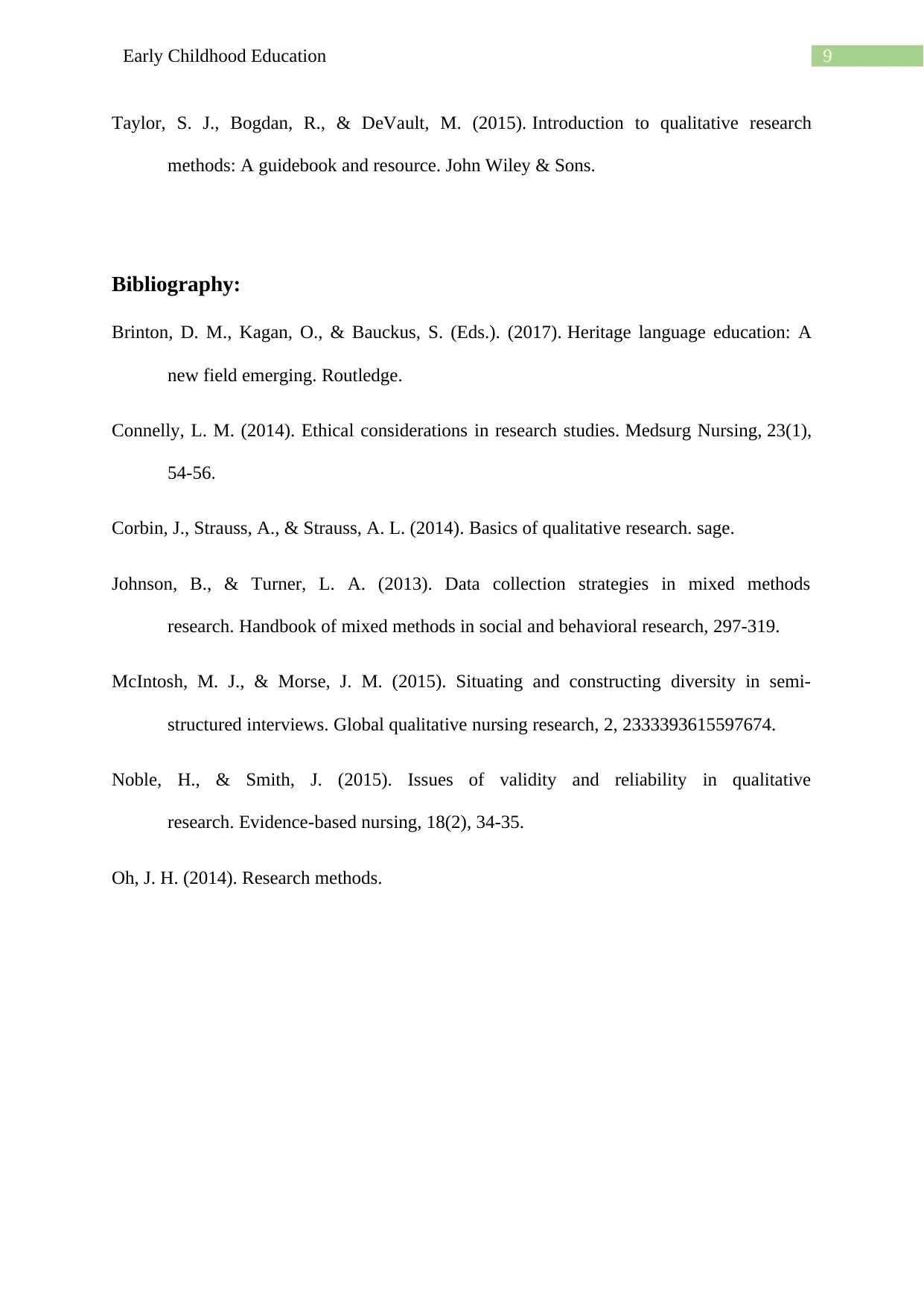
9Early Childhood Education
Taylor, S. J., Bogdan, R., & DeVault, M. (2015). Introduction to qualitative research
methods: A guidebook and resource. John Wiley & Sons.
Bibliography:
Brinton, D. M., Kagan, O., & Bauckus, S. (Eds.). (2017). Heritage language education: A
new field emerging. Routledge.
Connelly, L. M. (2014). Ethical considerations in research studies. Medsurg Nursing, 23(1),
54-56.
Corbin, J., Strauss, A., & Strauss, A. L. (2014). Basics of qualitative research. sage.
Johnson, B., & Turner, L. A. (2013). Data collection strategies in mixed methods
research. Handbook of mixed methods in social and behavioral research, 297-319.
McIntosh, M. J., & Morse, J. M. (2015). Situating and constructing diversity in semi-
structured interviews. Global qualitative nursing research, 2, 2333393615597674.
Noble, H., & Smith, J. (2015). Issues of validity and reliability in qualitative
research. Evidence-based nursing, 18(2), 34-35.
Oh, J. H. (2014). Research methods.
Taylor, S. J., Bogdan, R., & DeVault, M. (2015). Introduction to qualitative research
methods: A guidebook and resource. John Wiley & Sons.
Bibliography:
Brinton, D. M., Kagan, O., & Bauckus, S. (Eds.). (2017). Heritage language education: A
new field emerging. Routledge.
Connelly, L. M. (2014). Ethical considerations in research studies. Medsurg Nursing, 23(1),
54-56.
Corbin, J., Strauss, A., & Strauss, A. L. (2014). Basics of qualitative research. sage.
Johnson, B., & Turner, L. A. (2013). Data collection strategies in mixed methods
research. Handbook of mixed methods in social and behavioral research, 297-319.
McIntosh, M. J., & Morse, J. M. (2015). Situating and constructing diversity in semi-
structured interviews. Global qualitative nursing research, 2, 2333393615597674.
Noble, H., & Smith, J. (2015). Issues of validity and reliability in qualitative
research. Evidence-based nursing, 18(2), 34-35.
Oh, J. H. (2014). Research methods.
1 out of 10
Related Documents
Your All-in-One AI-Powered Toolkit for Academic Success.
+13062052269
info@desklib.com
Available 24*7 on WhatsApp / Email
![[object Object]](/_next/static/media/star-bottom.7253800d.svg)
Unlock your academic potential
Copyright © 2020–2025 A2Z Services. All Rights Reserved. Developed and managed by ZUCOL.





